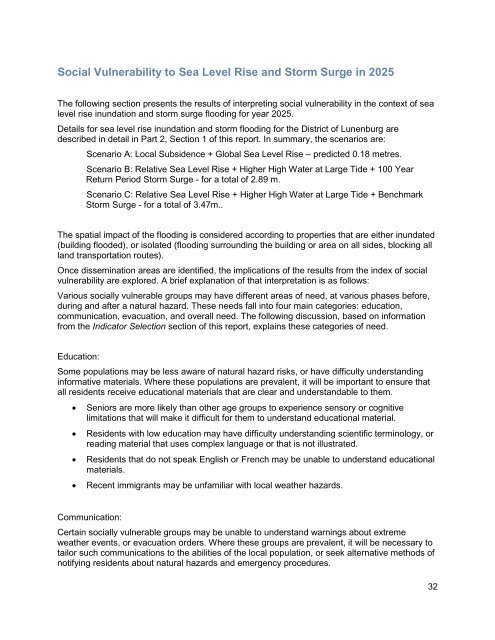Lunenburg Part 2 - Section 5 - Social Vulnerability - August 30.pdf
Lunenburg Part 2 - Section 5 - Social Vulnerability - August 30.pdf
Lunenburg Part 2 - Section 5 - Social Vulnerability - August 30.pdf
You also want an ePaper? Increase the reach of your titles
YUMPU automatically turns print PDFs into web optimized ePapers that Google loves.
<strong>Social</strong> <strong>Vulnerability</strong> to Sea Level Rise and Storm Surge in 2025<br />
The following section presents the results of interpreting social vulnerability in the context of sea<br />
level rise inundation and storm surge flooding for year 2025.<br />
Details for sea level rise inundation and storm flooding for the District of <strong>Lunenburg</strong> are<br />
described in detail in <strong>Part</strong> 2, <strong>Section</strong> 1 of this report. In summary, the scenarios are:<br />
Scenario A: Local Subsidence + Global Sea Level Rise – predicted 0.18 metres.<br />
Scenario B: Relative Sea Level Rise + Higher High Water at Large Tide + 100 Year<br />
Return Period Storm Surge - for a total of 2.89 m.<br />
Scenario C: Relative Sea Level Rise + Higher High Water at Large Tide + Benchmark<br />
Storm Surge - for a total of 3.47m..<br />
The spatial impact of the flooding is considered according to properties that are either inundated<br />
(building flooded), or isolated (flooding surrounding the building or area on all sides, blocking all<br />
land transportation routes).<br />
Once dissemination areas are identified, the implications of the results from the index of social<br />
vulnerability are explored. A brief explanation of that interpretation is as follows:<br />
Various socially vulnerable groups may have different areas of need, at various phases before,<br />
during and after a natural hazard. These needs fall into four main categories: education,<br />
communication, evacuation, and overall need. The following discussion, based on information<br />
from the Indicator Selection section of this report, explains these categories of need.<br />
Education:<br />
Some populations may be less aware of natural hazard risks, or have difficulty understanding<br />
informative materials. Where these populations are prevalent, it will be important to ensure that<br />
all residents receive educational materials that are clear and understandable to them.<br />
<br />
<br />
<br />
<br />
Seniors are more likely than other age groups to experience sensory or cognitive<br />
limitations that will make it difficult for them to understand educational material.<br />
Residents with low education may have difficulty understanding scientific terminology, or<br />
reading material that uses complex language or that is not illustrated.<br />
Residents that do not speak English or French may be unable to understand educational<br />
materials.<br />
Recent immigrants may be unfamiliar with local weather hazards.<br />
Communication:<br />
Certain socially vulnerable groups may be unable to understand warnings about extreme<br />
weather events, or evacuation orders. Where these groups are prevalent, it will be necessary to<br />
tailor such communications to the abilities of the local population, or seek alternative methods of<br />
notifying residents about natural hazards and emergency procedures.<br />
32














